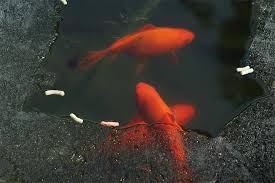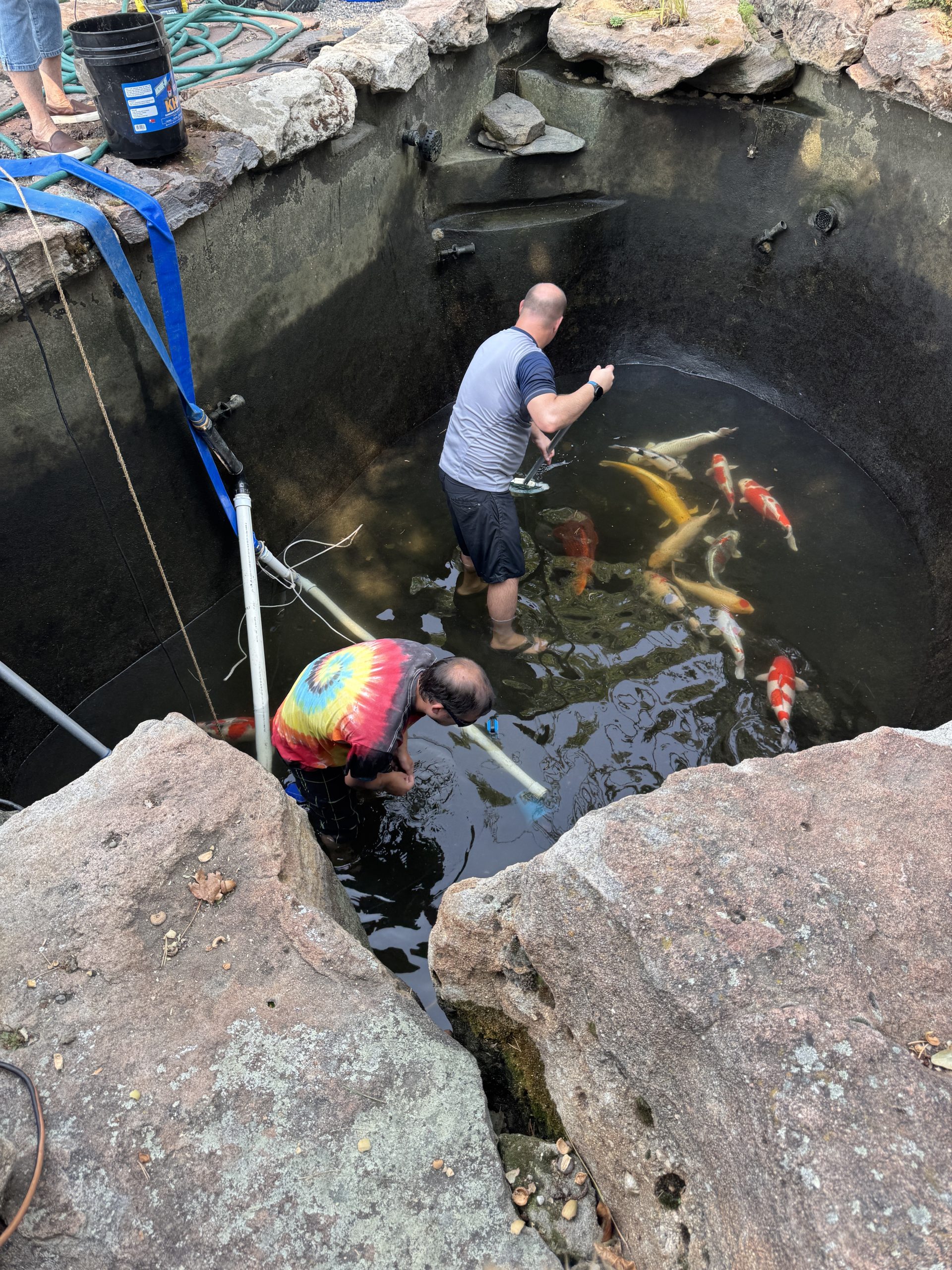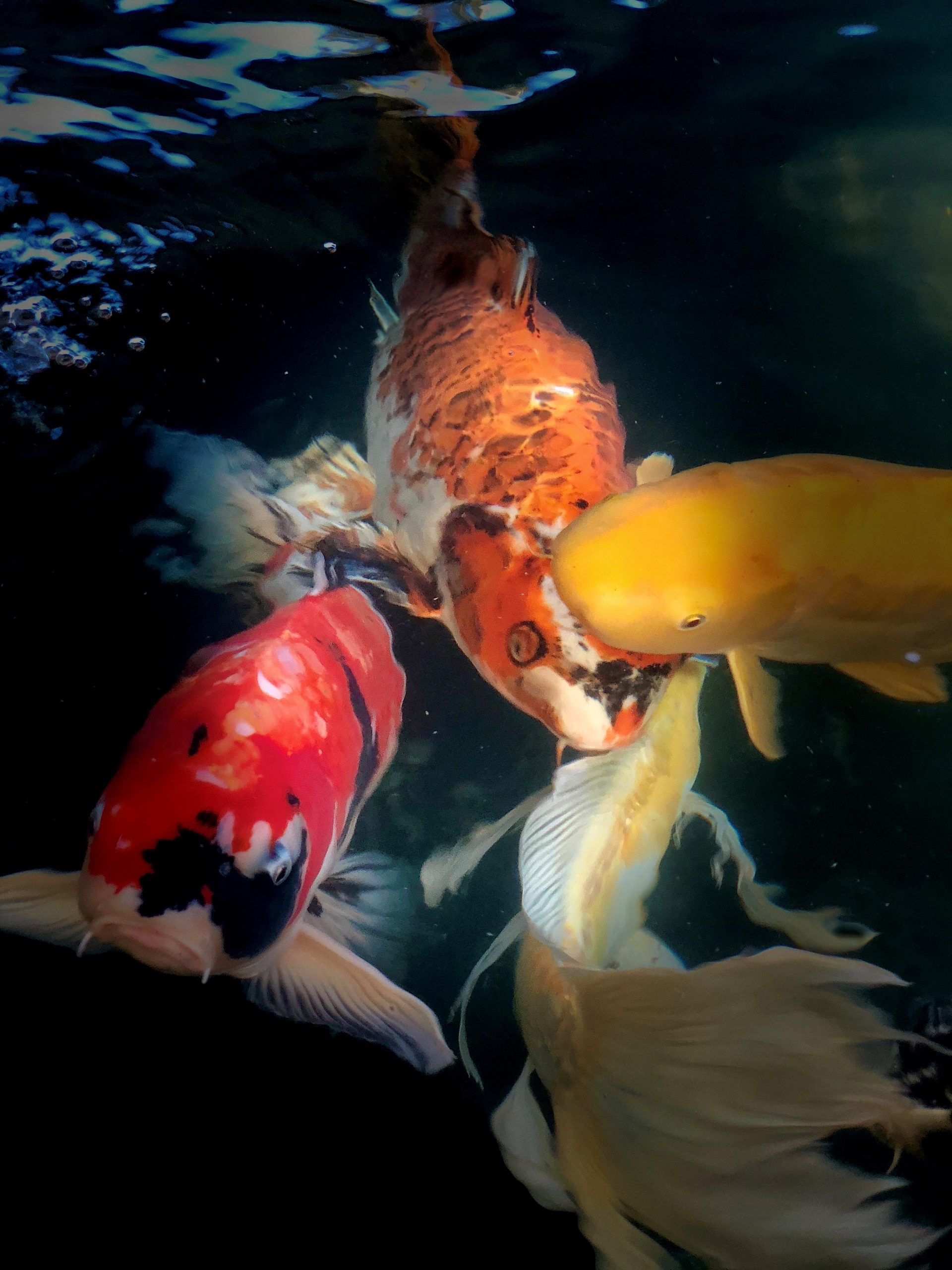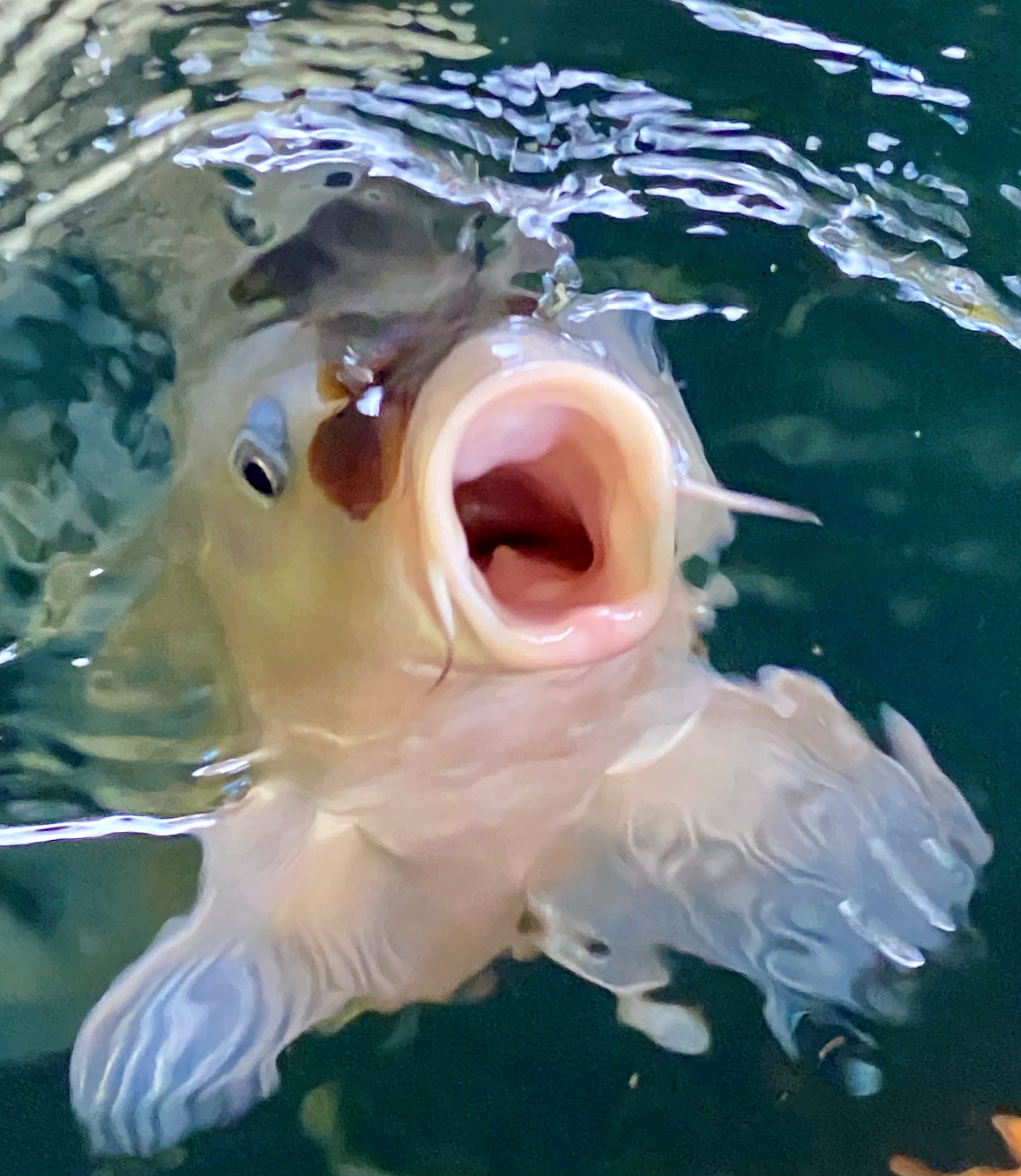Winter Pond Preparations
By Carolyn Weise
Published on August 27, 2023
As seen in POND Trade magazine. https://www.pondtrademag.com/winter-pond-preparations/

Ponds in areas that can reach freezing temperatures need special attention to ensure any fish can survive the winter. If this is your customer’s first winter with their beautiful koi pond, they need to know that there are some changes in the pond that cannot be avoided as the fall season heads into winter. In preparation, will they cover the pond, or will they choose to enjoy it in its raw elemental beauty? Any lilies should be cleaned of dead or dying foliage and then placed at the bottom of the pond if the pond is sufficiently deep to overwinter (3 to 5 feet deep) and will not take up space needed for the fish.
Things to Consider for Winter Pond Preparations

lice (right, top) are just one type of deadly parasite that prey on our koi. Use an aerator (right, bottom)
to keep an opening during winter.
New pond owners need to know the exact volume and, for overwintering fish, the depth of their pond. This does not mean a ballpark guess. In northern areas, all fish do best in adequately deep ponds. I do I hear a lot of people say, “In my area, we are not allowed to have a pond deeper than 18 inches,” and then they put koi in that pond. The truth is they can probably have a deeper pond if they are willing to have a security fence around it.
Know the size, type and amount of fish, type of fish. Are there koi, goldfish or other species? What frost zone are they in? What is the potential duration of freeze? If the pond might freeze for any length of time, there will be a danger of carbon dioxide toxicity buildup and oxygen depletion. Is the plumbing protected from severe cold? Are they able to leave a pump running to circulate the pond, while turning off waterfalls and streams that might freeze? Will they be able to remove and store the pump in water for the winter?
Is the pond overly full of fish? Is the pond in an area with wind protection? (Berm? Buildings? Fences?) For the safety of the fish and others during heavy snow, clearly mark the pond. Plan to keep a sufficient space open in the ice if needed. If they have an auto-refill feature, do you have a date to blow out the lines for winter?
Be Ready for Emergencies
Emergencies happen! Are they stocked up on Dechlorinator? Will they have a hospital tank and a place indoors if necessary to use it? What about the proper bacteria to cycle it? Will they have their hoses staying warm & dry, indoors, in case of emergency? If they leave for the holidays or the whole winter, do you store your customers’ fish?
Early Preparation
Those who know what works in ponds may not be available during winter season. Early preparation is the best defense. When asked, pond owners are generally looking for the same results as the pond professionals — both want to promote healthy fish that can withstand a cold, hard winter. They want a clean pond and no fish losses.
You are their guru. Once built, your customers need you to help them reduce stress on the fish during their first winter with the pond.
The Biggest Winter Stresses on Koi:
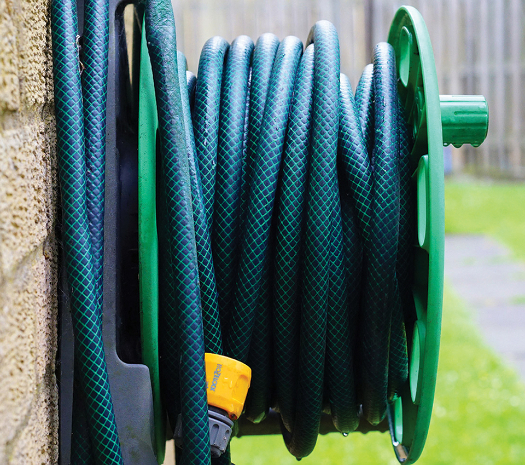
1. Cold. Koi are poikilotherms (cold blooded) and cannot warm each other up. They will be as warm as the water temperature. The ideal temperature range for koi is between 59°F (13°C) and 77°F (25°C), but if they are in good shape, they can withstand temperatures down to 34˚F (1˚C) for brief periods in winter. The issue is that in shallow ponds (1 to 2 feet), the 34˚F (1˚C) temperature at the bottom of the pond means the top may be frozen, factoring into account icy winds and falling night temperatures.
2. Overcrowding. Heavy stocking density is stressful to fish at any time, but in winter, the fish under ice are stressed due to oxygen shortage. Even while not eating, the fish give off carbon dioxide and take in oxygen while at rest (torpor). Ammonia is also a by-product of their dormant breathing. If the pond has enough opening at the surface to allow carbon dioxide release, will those fish in the areas away from that opening be able to survive on the available oxygen in the water? The more fish, the more oxygen used and CO2 given off. When oxygen is in short supply, the largest fish will die first.
3. Poor water conditions. Winter is the setting for the never-ending onslaught of falling leaves, most of which seem to end up in the bottom of the pond. Degrading leaves are a perfect storm for parasites and disease. Leaves may also lower the pH in the water over the winter. If leaves are allowed to build up in the bottom of the pond year after year, they can produce toxic gas over time, turning to methane. If fish or frogs die in the water, the ammonia produced can become toxic to your fish by spring.
4. Predators. Herons, osprey and other predators need to eat through winter and find easy prey in backyard ponds. During winter, trees are bare, and pond plants are dormant, giving little or no protection to the fish. Raccoons do not swim for their meal but will readily take a fish left behind by the heron.
5. Cold-water parasites. Ich, chiladonella, flukes, anchorworm, trichodina, fish lice and costia are all pond parasites that thrive in cold water. Of these, the Ich, flukes, anchorworm, costia and lice are deadly in a short period of time, especially when the fish are cold stressed and have no functioning immune system. Trichodina is common in ponds and easily killed by pond salt; they will make fish super-uncomfortable. While Malachite Green is the most effective treatment for these parasites, the treatment with formalin cannot be used at temperatures below 50˚F.

feeding stops around 50˚F. That’s too cold to feed!
The other issue is that mid-winter, most pond owners are not able to recognize a problem. Fish immune systems are not fully functional until the water is at 70˚F. So, while treating a problem earlier may remove the problem, the fish cannot help with the healing process. People may notice that their fish do not seem to be healing. That would be correct. They cannot do much about healing until the pond water is warm enough to support their immune systems. It does not mean the fish requires subsequent treatment. This is a frustrating time for the fish owners, i.e., simply a waiting period.
6. Pond Construction. While not especially the prettiest, the cleanest pond is the one with bottom drains and tangential pond returns. This leaves no stagnant areas or places for uneaten food and fish waste to gather on the bottom. It leaves no organic waste to be vacuumed or netted out. It is a continually functioning system. Pond construction can prevent predator attacks through the addition of rocks and plants along the perimeter to make it more difficult for one to chase and catch the fish; and it will not have plant ledges, also known as predator feeding stations. While pleasing to the eye, these become stressors for the fish.
Yes, fall is the beautiful unraveling of the summer season. The lovely tree-leaves display will soon be on the ground and in the pond. As surely as fall follows summer, we will see cold winds and cooler nights. The days will grow shorter. Koi will go into torpor as the temperature drops and their metabolism slows down. A clean pond as we enter winter months is important.
Facts & Myths
Pond owners want a product or products that will help relieve the stress of the coming season with its potential issues, but what they need is the education about what they can do at each time of year. There is no scientific data to prove that fish will die as the result of winter feeding or that undigested food will rot in their stomachs.
I used my fish to experiment one year. I fed them through the winter months, and each time they came to the side, looking for food even though the water was below 50°F. No fish died. They all remained happy and healthy. When I moved to Florida, I was told that fish that are fed all year live half as long as those that have the winter sleep. Is that fact or myth?
Here are a few more facts and myths:
1. Breaking the Ice. Will I kill my fish by using a hammer to break the ice in winter? Probably not outright, but your fish will waste good energy trying to escape the noise that takes them hours or days to recover from, especially if you do this repeatedly. Stress does kill fish.
2. Supercooling. Water exposed to air-cooled temperatures, such as that within a waterfall or stream, can supercool ponds by quickly dropping the water temperature, commonly as the sun goes down. A sudden decrease in temperature can negatively stress your koi. If you have an external water feature, it is recommended to bypass it during very cold weather conditions.
3. Oxygen Access. Even in torpor, your fish will need oxygen to survive. A solid-ice surface cuts off fish from life-saving oxygen. You must keep an opening at the water’s surface in order to keep your fish alive. You can do this by installing a pond deicer or aerator. Pond deicers work by thawing a small area of your pond surface in order to allow for air to penetrate into the water and the release of CO2.
Check deicers frequently in order to ensure proper function. Thermally activated, they do not heat the whole pond, only a small area of the water at the pond surface. When using an aerator, you do not want to bring the warmer water from the bottom of the pond to the surface using a bubbler on the bottom. Place air stones just below the surface in the winter.
4. Crowding. Although not scientific, an easy way to figure a safe number of koi in the pond, at any time, would be a minimum of 10 gallons per 1 inch of fish. Remember that koi can grow to 36 inches at full size. This is beneficial in feeding, creates less stress for the fish and results in much better water quality.
5. Evaporation. Can water evaporate in ice-covered ponds? Yes. Monitoring the water level. Use Dechlorinator before adding new water.
6. KH. Do I have to monitor the KH in winter? Yes. you may prevent a pH crash.
7. Ammonia. Do I have to worry about ammonia spikes in winter? The danger is when water begins to warm.
8. Sick Fish. What can I do if I find a sick fish in the middle of winter? In order to be effective, most treatments should be done at 70°F when the fish have their full immune system working. This allows the fish to heal while you treat whatever is causing the problem. The best scenario would be to bring the sick fish indoors, where it will need to remain for the rest of the winter.
9. Frozen Pipes. If you experience broken pipes due to the low temperatures, the pond can empty rapidly, leaving fish high and dry on the bottom. The best scenario would be a temporary pond in the house or garage to house them until spring, when you can fix the plumbing.
Armed with this list of potential problems, hopefully nobody’s pond should have trouble on your watch in winter. A problem anticipated is trouble prevented. Take care of business and have an uneventful winter!

